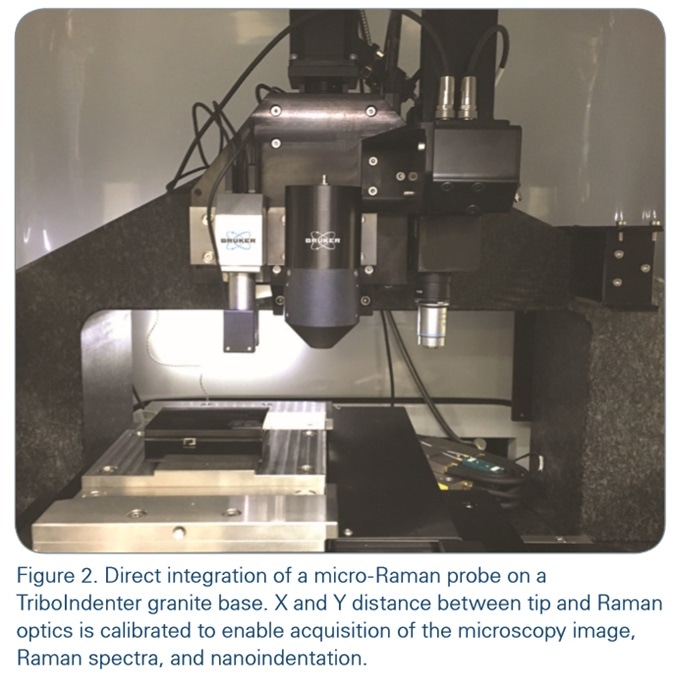A tooth is made up of enamel and dentin. The enamel is the harder outside of the tooth while the softer inside substance is the dentin. The enamel is composed of a mineral, chiefly carbonated apatite, interspersed with a little organic matter.

The mineral phase is detected by the high amount of phosphate in it, as seen in Figure 1, while the organic phases are identified by amide Raman bands.

The hydroxyapatite content determines the intensity of each mineral peak, and the mechanical properties of the tooth. Bruker introduced a new nanomechanical test device, the Hysitron® TI series TriboIndenter, fitted with Raman spectroscopy, to help conduct biomaterials research, as shown in Figure 2.

Combining these two technologies enables both the nanoscale mechanical properties of a material on a small scale as well as the relationship of these characteristics to the chemical composition to be studied. The use of Raman spectroscopy to detect the phonon or vibrational state of a molecule yields a molecular profile of the physical state the material is in.

The nanoindentation curve performed on the material at the same time characterizes its mechanical properties. Thus, this combination gives a comprehensive description of how the composition, the structure and properties of a material are related to each other.
Procedure
In this experiment a rat incisor was first dried and then embedded in epoxy resin. Subsequently sagittal sections were made and these were polished smooth. Both Raman spectroscopy and nanoindentation measurements were automatically performed over the surface, in an array of points 30 microns apart, including both enamel and dentin. A Hysitron TriboIndenter equipped with a Berkovich indenter was used to collect Raman spectra using laser at an excitation wavelength of 785 nm within a range of 50 to 1800 cm-1 with the laser spot size being approximately 2 microns. A 50x objective of NA 0.55 was used to focus the laser on the automatically defined indentation points.
Results
An optical micrograph was overlaid using both Raman data and indentation maps of the same surface. This showed that the mineralization decreased from the outer layer of enamel to the dentin, correlated with reduction in elastic modulus. The mineral content and elastic modulus were highest at a point very close to the apex of the incisor.
Conclusions
This instrument makes use of Raman spectroscopy to establish chemical composition with concurrent modulus/hardness mapping using nanindentation, to allow a correlation between these results, which reveals the effect of chemical composition upon the mechanical properties. These methods are complementary to each other, and in the present case they show how the mineral content of the tooth substance is related to its stiffness.
References
- Nanoindentation mapping reveals gradients in the mechanical properties of dental enamel in rat incisors, B. Frydova, J. Sepitka, V. Stejskal, F. Fryda, J. Lukes, Comput. Methods Biomech. Biomed. Engin., Vol. 16, 290-291, 2013.
- Molecular Spectroscopy Study of Human Tooth Tissues Affected by High Dose of External Ionizing Radiation (Caused by Nuclear Catastrophe of Chernobyl Plant), L. A. Darchuk, L. V. Zaverbna, A. Worobiec, R. Van Grieken, Current Topics in Ionizing Radiation Research, InTech, 2012.
About Bruker Nano Surfaces
 Bruker manufactures world class atomic force microscopes and other nano technologies that incorporate the very latest advances in AFM techniques, including the revolutionary ScanAsyst™ AFM imaging mode and the PeakForce QNM® atomic force microscopy imaging mode to ideally suit a wide array of application areas, from biology to semiconductors, from data storage devices to polymers, and from integrated optics to measurement of forces between particles and surfaces.
Bruker manufactures world class atomic force microscopes and other nano technologies that incorporate the very latest advances in AFM techniques, including the revolutionary ScanAsyst™ AFM imaging mode and the PeakForce QNM® atomic force microscopy imaging mode to ideally suit a wide array of application areas, from biology to semiconductors, from data storage devices to polymers, and from integrated optics to measurement of forces between particles and surfaces.
Sponsored Content Policy: News-Medical.net publishes articles and related content that may be derived from sources where we have existing commercial relationships, provided such content adds value to the core editorial ethos of News-Medical.Net which is to educate and inform site visitors interested in medical research, science, medical devices and treatments.